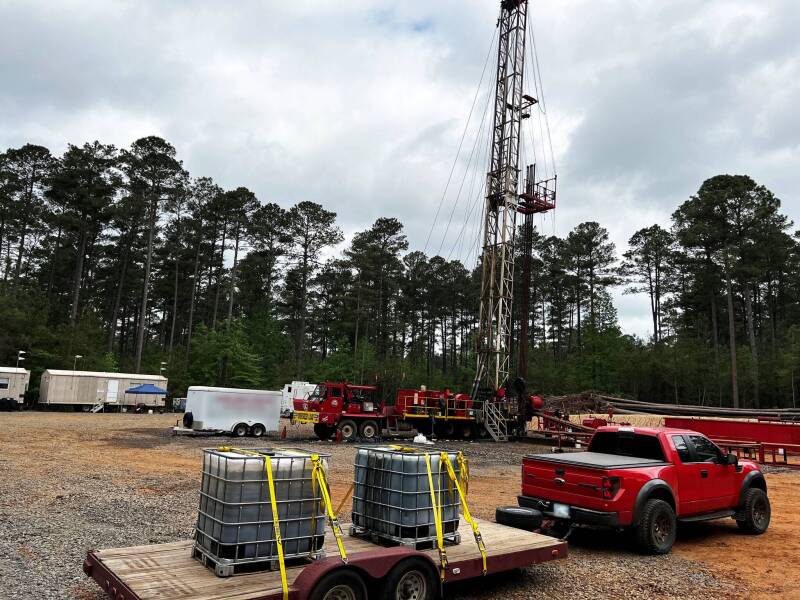ExxonMobil has reportedly struck a deal for the drilling and production rights of an expansive lithium brine reservoir in southern Arkansas for upward of $100 million.
This is according to the Wall Street Journal, which was the first to report on the US supermajor’s acquisition of privately held Galvanic Energy.
The deal includes more than 120,000 gross acres in the Smackover formation which is an upper Jurassic rock found at depths of about 9,000 ft. A highly sought-after oil and gas prospect in the 1940s, the Smackover is today known more for making Arkansas the world’s second-largest supplier of bromine.
Like the bromine, the lithium in the Smackover is found in the oilfield brine and therefore can be sourced using many of the same technologies used in the oil and gas industry.
Drilling for Electric Cars
The Smackover’s location in the south central US puts ExxonMobil in a position to potentially become a key supplier to the nation’s growing domestic electric vehicle (EV) manufacturing base which requires lithium to make batteries. The US is currently home to just one lithium mine in Nevada, though more are planned to be built there to keep pace with rising global demand.
Oklahoma City-based Galvanic estimates the acreage holds 4 million tons of lithium carbonate equivalent (LCE)—a standardization metric used in the lithium mining industry—which it says is enough to help build 50 million EVs.
Galvanic also reports that test wells drilled recently showed an average LCE quantity of 325 mg/L which it claims as the highest concentration of any lithium brine reservoir in North America.
Other lithium explorers are also targeting the Smackover, including Standard Lithium which began an appraisal campaign in March that involves drilling new wells and reentering some that have been plugged and abandoned since the 1980s.
These projects are all being funded on hopes that an emerging technology known as direct lithium extraction (DLE) will be successful at scale.
Compared with open-pit mining and the use of evaporation ponds, which deliver most of the world’s supply of lithium today, DLE has more commercial uncertainties. But it also holds the potential to unlock new sources of battery-grade lithium, such as depleted oil and gas fields, and comes with a smaller environmental footprint than other extraction methods.
Galvanic has previously said independent testing performed last year proved that the Smackover oil brine is compatible with DLE technology. The test involved 50,000 gallons of oilfield brine with a concentration of about 300 mg/L of lithium. Galvanic reported 89% of the lithium was recovered using a modular DLE plant. Notably, the firm added the naturally hot reservoir fluid temperatures of 200°F aid the absorption process that is key to the DLE technology.
From a high level, DLE systems resemble small oil and gas processing facilities or even water plants. They precipitate lithium from brine using filters, membranes, ceramic beads, or other separation technologies. (Learn more about DLE in this JPT feature article.)
In addition to this development, ExxonMobil is tied to another lithium project through its Albertan subsidiary Imperial Oil Ltd.
Together with metals company E3 Lithium, Imperial is aiming to launch a pilot DLE plant later this year at the Leduc oil and gas field which spurred the rise of the oil and industry in Alberta upon its discovery in 1947. The partially government-funded project has so far resulted in three test wells that showed the reservoir has a lithium concentration of 75 mg/L.
Notably, ExxonMobil’s progress in the Smackover may offer a new hope to other oil and gas fields that have been passed over in recent years.
A little over a decade ago the Smackover was one of several formations considered by oil and gas operators to have a bright future as an unconventional oil and gas play. However, the source rock known as the Brown Dense Lime did not turn out to be economic and drilling plans were mostly abandoned by 2015.
A similar story played out for unconventional developments in Oklahoma’s Mississippi Lime and Louisiana’ Tuscaloosa Marine Shale. For various reasons, both rock targets failed to join the ranks of the US shale revolution's most important plays. But based on wastewater analysis, they are believed to hold higher-than-average concentrations of lithium compared with more successful oil and gas plays


